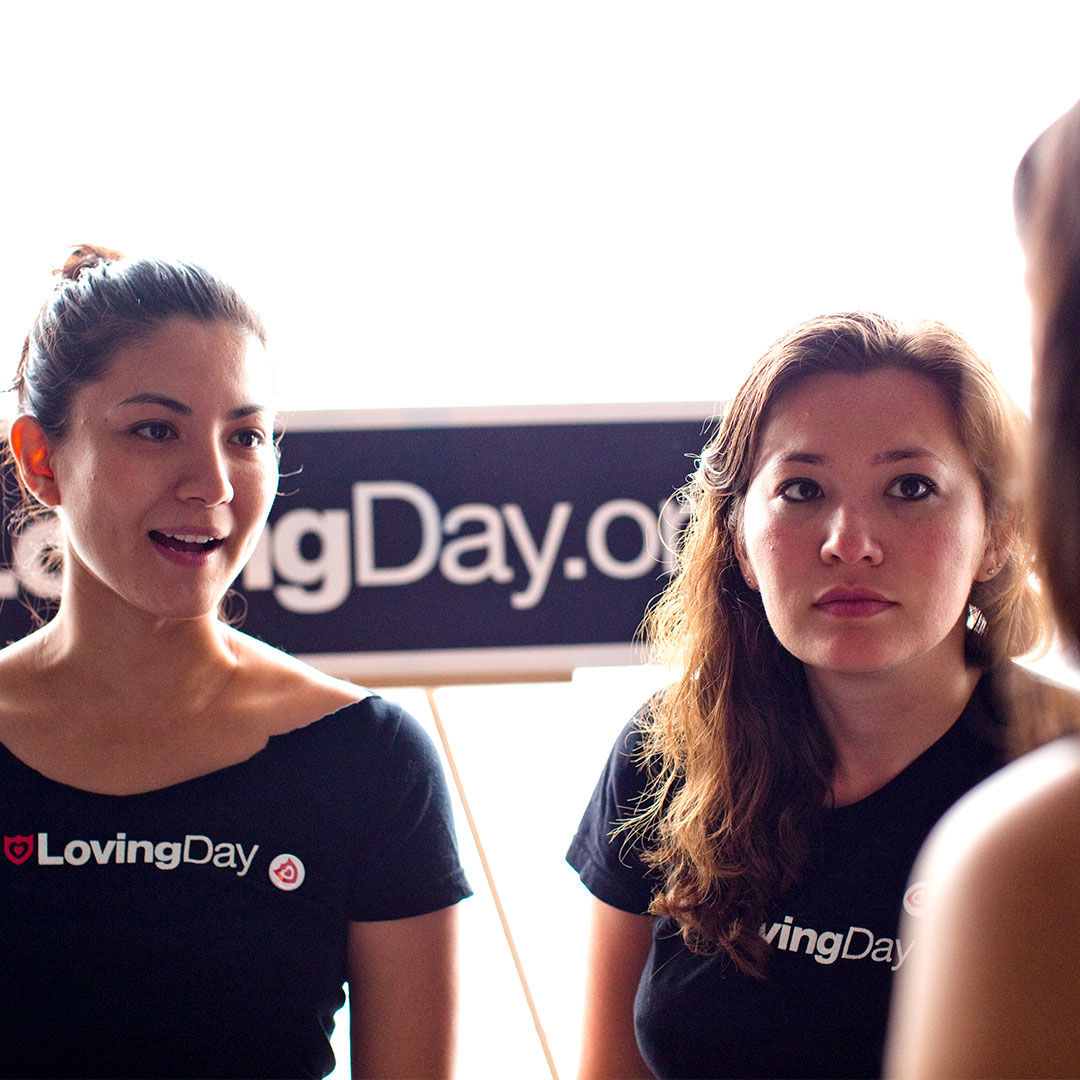
What are the roots of Loving Day?
Our Project
We build a shared tradition to connect a diverse global community.
Loving Day is a community project stewarded by volunteers. We cover our expenses with kind donations of any size (mostly small) and with sales through our Loving Day stores.
Our mission is to steward a shared Loving Day tradition as a way to fight racism through education, create visibility, and build community.
Here’s how we believe our work fits in to the bigger picture.
Engage
Begin with the Loving’s story and court case as an engaging starting point for exploring complex intersections of race, identity, love, and justice.
Education
Develop educational resources related to Loving, and provide pathways to related resources beyond our capacity and expertise.
Visibility
Share Loving Day as a platform for collective visibility within and beyond our community, and as a source of individual affirmation.
Community
Create and nurture a shared Loving Day tradition that connects a global community, which makes our collective work sustainable, and enables greater impact.
Welcome
Invite and inspire participation, learning, and action by being open and welcoming, and by crafting resources that are understandable and shareable.
Service
Listen to and serve our diverse global Loving Day community, and serve communities that intersect with ours by sharing our strengths.
Focus
Apply limited resources with a focus on our mission, but with intention as a small yet meaningful part of a larger movement towards racial justice and equality.
Love
Act from a place of love and compassion, acknowledging that “loving” each other is deeply personal, our lived experiences are unique, and we are at different points in our own journeys.
The symbol in the Loving Day logo has two parts: the heart and the shield. Each part represents an equally important piece of the project’s spirit.
The Heart
The heart represents Richard and Mildred Lovings’ last name, the Loving court decision, and the love we share with each other as couples, families, and as a community.
The Shield
The shield represents the equal legal protections we should all have, the right to love, and the strength that comes from our connection as a community.
For questions about using our symbol or logo, see our FAQ.
Loving Day was created by Ken Tanabe, a designer and the son of Japanese and Belgian immigrants. It started as his graduate thesis project at Parsons School of Design in New York City.
As a student, he developed the concept, name, logo, website (version 1), and other graphic materials. The project was publicly launched after his graduation in 2004, which included the first Loving Day “flagship” event.
With the help of many volunteers and supporters, Loving Day grew from a student project to a global movement with events all over the world, major press, official recognitions, and a hashtag that has trended multiple times.
Most importantly, it has become a meaningful tradition that can be shared between friends and family, and passed down between generations.
2003
- Ken Tanabe begins research and work on Loving Day as his graduate thesis at Parsons School of Design in New York City
2004
- Loving Day launches publicly
- Website version 1 launches
- First Loving Day “Flagship” event in New York City
2005
- First offical recognition of Loving Day in Eugene, OR obtained by H.O.N.E.Y. (Honoring Our New Ethnic Youth)
2006
- First national media coverage (Washington Post)
2007
- First global media coverage and television coverage (BBC World)
- Around 1000 guests attend the Loving Day “Flagship” event in New York City
- Loving Day recognized in a U.S. House of Representatives resolution
- Website version 2 launches
2008
- First official Loving Day t-shirt sold in online store
2009
- First known public Loving Day events outside of the U.S. (in Barcelona and in Kobe, Japan)
2010
- First known Loving Day wedding
- Loving Day featured in Time
2011
- Loving Day officially recognized in the Loving’s home town of Caroline County, VA.
- Loving Day events in 30 cities in one year
2012
- Gilbert Holmes, former executive director of the ACLU of Indiana, hosts a Loving Day ice cream social in an Indianapolis swimming club that didn’t allow Black people as members until 1982
2013
- Tenth annual Loving Day “flagship” event in New York City
First known public Loving Day event in the Netherlands
2014
- Over 200 known past public Loving Day events worldwide
2015
- First state-level official recognition of Loving Day (Virginia Governor Proclamation)
- Loving Day events in a record six countries in a single year (U.S., France, the Netherlands, England, Japan, Taiwan)
- A fictional novel called Loving Day is released, written by award-winning author Mat Johnson
2016
- Loving Day collaborates with Focus Features to promote the Oscar-nominated film Loving
- First known public Loving Day events in Austria and Denmark
2017
- The #lovingday hash tag trended for the first time on Twitter (at #3 in the U.S.)
- A record 50 known public Loving Day events are announced in a single year
- Loving Day hosts two “flagship” events in one day in New York City in honor of the 50th anniversary of the Loving decision
- Second state-level official recognition of Loving Day (California State Assembly Resolution)
- Loving Day added to the ADL (Anti-Defamation League) Calendar of Observances
- First known public Loving Day event in Germany
2018
- First known public Loving Day event in Switzerland
2019
- First known public Loving Day event in Italy
2020
- Loving Day “flagship” event was not held for the first time since 2004, at first because of the COVID-19 pandemic, and then to focus attention on the movement for racial justice following the murder of George Floyd
- Loving Day shared a Black Lives Matter statement on our website home page, social media, and in the press
- The #lovingday hash tag trended for the second time on Twitter (at #5 in the U.S.)
- USA Today article on Loving Day is the 9th most engaged web content on Facebook in Q2 2020
2021
- The #lovingday hash tag trended for the third time on Twitter (at #5 in the U.S.)
- Loving Day website version 3 launches
- First known public Loving Day event in Belgium
Loving Day was inspired by the work of many others who came before. These are some of the most important examples.
Commemorative observances
Loving Day was partly inspired by Juneteenth (June 19th), which celebrates the emancipation of enslaved people in the U.S. A deeply meaningful tradition that has been observed since 1866 by millions of people, it was made a federal holiday in the United States on June 17, 2021.
Loving Day was also inspired by government-recognized heritage months such as Black History Month, and holidays like Martin Luther King Jr. Day.
Stories that teach important lessons
The Loving Day Story is inspired by stories that are used to teach the history of civil rights in the U.S. For example, the Rosa Parks story is often used to explain some of the indignities of racial segregation. The Emmett Till story is an example of the brutality of anti-Black violence, the racial inequality of the legal system, and the extreme racism associated with even the suggestion of interracial relationships.
Past multiracial community organizations
Before Loving Day launched in 2004, other organizations were already serving the multiracial community. While many of these are no longer active, some continue to serve the community.
Some of these organizations acknowledged the anniversary of the Loving decision prior to 2004 in some way. For example, Interracial Family Circle (IFC) and AMEA (Association of Multiethnic Americans) hosted a conference in Maryland in 1992 for the 25th anniversary of Loving v. Virginia.
Loving Day built on this work by creating the Loving Day name, framing it as a shared annual tradition that could be observed by anyone, and bringing it into the global consciousness through press, social media, and events.




